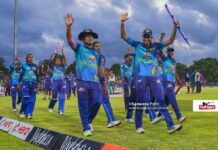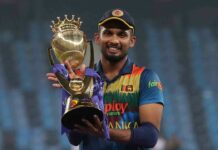“Wrong place, wrong time” were two of the very first words Shehan Karunathilaka used when describing the fictional Lankan chinaman bowler Pradeep S Mathew. The same phrase can be used for many players.

Duleep Mendis, Roy Dias, Sidath Wettimuny, Aravinda De Silva – the list can be stretched to cover the distance between two sight screens in a cricket field. Sri Lanka, the emerald isle was not immune to cricket as it was to most of the other British influences. Cricket was a rum that Ceylon could not resist inebriating itself with.
Cricketing roots in Sri Lanka
In 1815 via a treaty, the last kingdom in Sri Lanka knelt down in front of the British. Ceylonese detested the British way of life, in general. Although the British Culture had its effects on Sri Lankan culture, it could never supplant it.
There was a monk who brought down the British flag and hoisted the Lion Flag minutes before the Lankans surrendered. There was a priest whose eloquence had Westerners sail to the isle to embrace Buddhism. Such was the culture-consciousness of the inmates of the island, that the British could not manage to inject their ideas into the Sri Lankan culture.
Cricket, however, found a different conduit. In a prudish society that has a phobia for western cultures, a sport born and brought up in an isle in the west, somehow, managed to mingle with the culture of Sri Lanka. Almost a century after the surrender, was born a man who adopted the British game and later the British way of life. A man who wielded the willow and wrote poems with it. A man who could stupor the fans with his titillating stroke making.

In fact, most of those would not even have been written had it not been for the notorious murder case of his wife.
What makes a player great? Number of articles written on him by scribes? Or the number of fans who call him the great? Has the number of Facebook likes or Twitter followers got an effect in measuring a player’s greatness? Almost a century after the birth of the batting supremo of Sri Lanka, he has no Facebook fan pages, no Youtube videos of his batting and almost no articles on him barring the ones written after his badass in Chepauk, Chennai in 1947. Who bothers to know that once upon a time in Sri Lanka, there lived a man who captained 3 national teams, was called “the best” by the great Garry Sobers, married a grand daughter of Sir Ponnambalam Ramanathan – a freedom fighter and was later arrested and acquitted for killing his wife?
Early life
Mahadevan Sathasivam, adorably called “Satha” was born on the 18th of October, 1915 in the then British controlled Ceylon. There aren’t many credentials available as to where he was born, where he grew up or where he learned his cricket. Just like the story of Pradeep Mathew in Chinaman, cricket has forgotten “Satha”. I don’t think even Wisden has particulars of him.
Satha started his cricketing life at St. Joseph’s College and later moved to Wesley College, Colombo. In a country where, having the chance of representing your school in cricket is a privilege, Satha as a wunderkind smashed all bowlers apart in the ground of one of the most privileged schools. His last season with Wesley is considered the best as he bid adieu to his school cricket with an excellently compiled 142 runs against St Thomas College, Mt Lavinia.
Sathasivam played during a time when Sri Lanka had no Test status. There weren’t tournaments with first-class status. Teams from England and Australia at times would stop in Sri Lanka for a game, en route to a tour to India. Or sometimes the Ceylon team would visit India, mostly Chennai and those were the only times Sri Lanka played first-class matches. Sathasivam played only 11 such first class games.
From Sri Lanka’s perspective there were international matches often played against Australia, Commonwealth XI and Madras. In those 11 games, Satha batted in 18 innings, scoring 753 runs at an average of 41.83 with 3 centuries and 3 fifties.
He had an unmatched club level record. He scored 44 centuries, with 4 double centuries, playing for Tamil Union. 753 runs at an average of around 42 and 44 centuries at club level can never make a batsman standout in modern times. But considering the fact that Ceylon never played many first-class matches, let alone Test matches and the very fact that batting was a tough art then, makes Satha incongruous from the rest. There are references to three great innings he played at the first-class level.
The three great knocks
The first one was played at the sanctified stadium at Chepauk, Madras. Sathasivam scored a record breaking 215 runs, playing for All Ceylon against South India. Sriram Veera, the chief cricket correspondent for Mumbai Mirror has said, “In the year 1947, a slim figure glided to the centre of the wicket with a ‘bewitching elegance’, his cap worn at a rakish angle, a white handkerchief tied around his neck, and proceeded to dispatch the ball to all parts of the ground while making 215. If the old timers are to be believed, that knock from Mahadevan Sathasivam, the legendary and flamboyant Ceylonese batsman, was the finest innings ever played at Chepauk.”
The “Madras Mail” in its obituary reported that Sathasivam who played the best ever three figure innings at Chepauk was no more. He vouched for his reputation as one of the best batsman of his era by sabotaging a bowling attack that consisted of “J. Gopalan and C.R. Rangachari, the latter in his heyday, and the spin of N.J. Venkatesan, Ghulam Ahmed, C.P. Johnstone and B.C Alva. ”
He bewitched the Madras crowd by scoring 215 runs breaking the then record of 213 runs. The report also claimed that even though players of the calibre of Jack Hobbs, Charlie Macartney, Jo Hardstaff, Dennis Compton, Lindsay Hassett, Garry Sobers, C.K. Nayudu, Vijay Hazare and Ren Nailer had entertained the cricekt savy Madras crowd with their batsmanship, but no one has ever played an innings of Satha’s class. The report further exulted Satha’s performance by saying that his batting was a mixture of Nayudu’s fireworks, Weekes’s footwork, Hassets’s subtlety and the driving power of Sobers.
The second innings was played against Commonwealth XI in 1950. The Ceylon team was all out for 153 runs, with Sathasivam scoring 96 of them. The innings of Sathasivam came against West Indians Frank Worrell, Geo Tribe, Fred Freer and GeoPope who were considered invincible then. Frank Worrell, the former West Indian captain, led the applause of his team as Satha walked to the pavilion. Not often would a batsman be given an ovation, while marching back to the pavilion. Warrell publicly proclaimed that if he was to pick a World XI, “Sathasivam from Ceylon” would be the first choice. Later, Warrell confided about Satha to Sir Garfield Sobers before Sobers came to Ceylon for a coaching spell. Later Garfield Sobers would call Sathasivam “the greatest batsman ever on earth”.
The third was played against India led by Vijay Merchant, where Satha amassed 111, enthralling the crowd against bowlers like Amarnath, Banerjee, Mankad, CS Nayudu, Hazare and Modi. At the end of the match, Vijay Merchant paid a visit to the Ceylon dressing room and gifted Satha a stump saying “in appreciation for a really fine innings”.
Accusation of murder
Mahadevan Sathasivam was a Don Juan. He could easily make any woman swoon for him. Smelling of booze and another man’s wife, Satha could haze the ball to all parts of the grounds. Sathasivam was gregarious that he could befriend anyone. Yet he had a sorry married life. In the early 1950s, he was accused of murdering his wife and was later exonerated. The negative publicity made him flee Ceylon and settle down in Singapore. He captained Singapore and later lead Malaysia.
A century has almost flown since the birth of the Sri Lankan Wizard. The phrase “the best batsman of Sri Lanka” will raise the names of Kumar Sangakkara, Mahela Jayawardene and Aravinda de Silva. You won’t hear anyone speak about Sathasivam in the same breath as Mahela or Sanga. The youth of Sri Lanka is unaware about the greatest batsman who captured the imagination of cricket loving enthusiasts in the 1940s. He wielded a bat that could silky dispatch balls to the boundary.
Only a few in the world had the ability to carry a bleak batting order on their shoulders. If a batsman could just walk in and play an innings of his life, while the rest struggle to get bat on ball, then that would vouch for his greatness. More often than not, Sathasivam played innings of this kind. It is a shame that he has played only 11 first-class games. The modern day experts will shun him when making a list of best batsmen.
The greatest Sri Lankan batsman that wasn’t
For many, 11 games would be grotesquely inadequate to measure a player’s brilliance. Sathasivam today will not make any all-time World XI. What he has done with the bat to bewitch fans has been forgotten. Even the ubiquitous, heavy memorised internet has only a few links leading to facts about Sathasivam.
Cricket has failed to pay heed to its son who made the bat speak. Sri Lanka has forgotten its crown prince who made sure cricket in the emerald isle perpetuated. A Tamil by birth captained a country with a Sinhala majority before the civil war in Sri Lanka broke out. Sathasivam could have been the prefect response to the diaspora which malignly claim that there is no place for Tamils in Sri Lanka cricket.
The word Sathasivam made the island stretch its lips, plump its cheek and brighten its face. Now the lips of Sri Lankans hardly utter the word Satha. Cheeks shrink and faces become perplexed when you hear the name Sathasivam. He is a forgotten prince of Sri Lanka cricket.



















